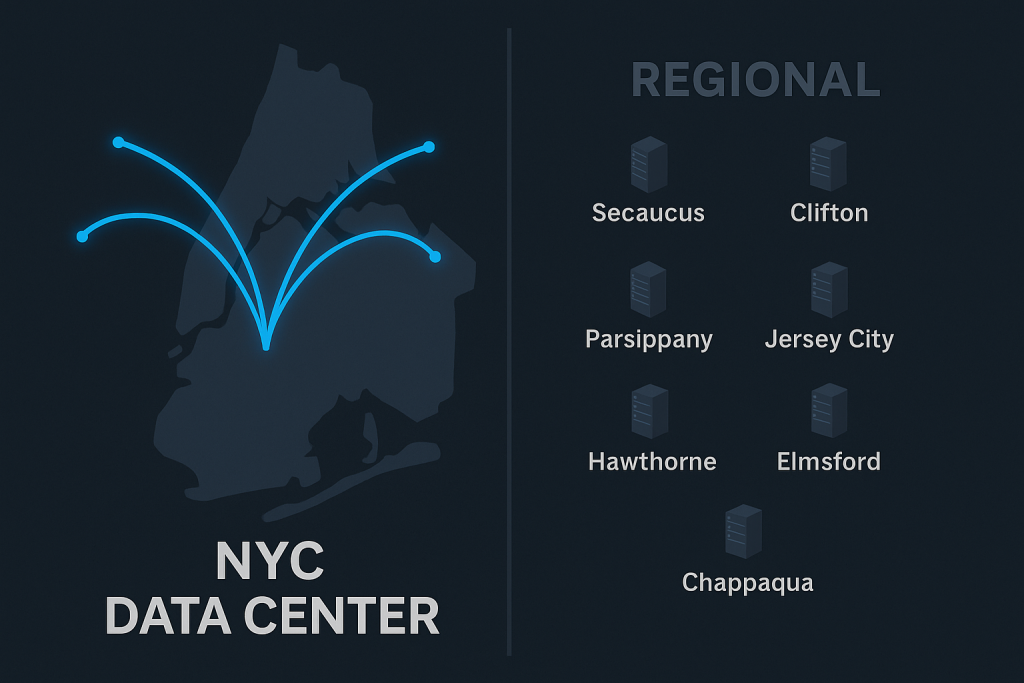True New York Data Centers vs Regional Providers
When every millisecond counts, a New York City data center in the heart of Manhattan is in a league of its own. If you’re comparing a true NY data center with facilities in Secaucus, Clifton, Parsippany, Jersey City, Hawthorne, Elmsford, Chappaqua, Long Island, or other Westchester spots, the choice is clear. Metanet offers unmatched locations, network quality, and service—and backs it with a software-driven network for instant provisioning and application development that no public-company REIT can match.
Manhattan: Closer Means Faster
Two legendary carrier hotels—60 Hudson Street and 111 8th Avenue—anchor the densest internet hub in North America. Right next to them runs the fiber-optic superhighway of 9th Avenue, a corridor loaded with high-capacity dark fiber and lit services from dozens of carriers.
Locating your infrastructure here gives you:
- Lower latency: No river crossings or long backhaul circuits to reach major networks.
- Massive capacity options: Multiple competing providers keep costs down and performance high.
- Future-proof scalability: Lighting new fiber pairs or adding wavelengths is quick and cost-effective.
For financial trading, ad-tech, SaaS, or streaming media, those microseconds and micro-hops translate directly into dollars and user experience.
Bandwidth and Peering Without Equal
Because Metanet’s NYC data center sits right on the 9th Avenue fiber corridor, you gain instant access to two of the world’s busiest internet exchanges: NYIIX and DE-CIX New York. A single cross-connect reaches hundreds of networks, clouds, and CDNs.
- Peering offloads traffic from transit, improving performance and reducing blended bandwidth costs.
- The 9th Avenue backbone lets you scale from a few gigabits to multiple terabits with minimal lead time.
- Low-latency cross-town routes reach the East Side or New Jersey in microseconds.
It’s world-class connectivity without middlemen or surprise transport fees.
Don’t Be Fooled by “NY” Names
Many facilities wear a New York label (eg. “NY1”) but aren’t really in the city:
- Equinix NY1 – 165 Halsey Street, Newark, NJ
- Equinix NY2 – 275 Hartz Way, Secaucus, NJ
- Equinix NY4 – 755 Secaucus Road, Secaucus, NJ
- CoreSite NY2 – 2 Emerson Lane, Secaucus, NJ
- CoreSite NY3 – 2 Emerson Lane, Secaucus, NJ
All respectable sites—but they’re not New York City data centers. Every extra mile of fiber between your servers and Manhattan’s core adds latency, complexity, and potential failure points.
Compare this to our data center locations which are truly inside NYC proper at strategically “curated” locations.
- 111 8th Avenue, Manhattan, NY (Googleplex – Google HQ Campus)
- 85 10th Avenue, Manhattan, NY (Chelsea Market, the Nabisco Factory – Also Google campus)
- 60 Hudson Street, Manhattan, NY (Western Union – The legendary Telegraph Building)
- 7 Teleport Drive, Staten Island, NY (The Port Authority of New York and New Jersey, PANYNJ)
- 882 3rd Ave, Brooklyn, NY (Industry City – Our 4G/5G Wireless data center outpost)
The Hidden Risks of Big-REIT Data Centers
Large publicly traded REIT operators focus on shareholders, not tenants. That mindset leads to design shortcuts most customers never see until something breaks:
- Flood exposure. Several NJ/NY REIT sites sit in flood-prone zones.
- Illusory fiber diversity. Many depend on the same wholesale carriers. They often enter a building from different manholes but converging into the same underground bundle. “Diverse” paths can share a single point of failure.
Case in Point: The 9th Avenue Manhole Fire of 2018
When a Con Edison manhole fire on 9th Avenue melted down fiber along the 9th avenue fiber corridor from wholesale providers like Verizon and OCG, half of Manhattan’s network traffic below 15th street went dark for DAYS. Numerous data centers and carriers discovered that their supposedly separate routes all relied on the same wholesale strands—and all failed simultaneously.
How Metanet Stayed Online
Metanet’s NYC data center never blinked. Why?
- We carefully vetted every underlying fiber provider and insisted on true physical diversity.
- Our network included independent wholesale carriers completely separate from the big incumbents.
- We built a redundant fiber ring west to 10th Avenue and out to Staten Island and New Jersey, which bypassed the damaged 9th Avenue routes.
- During the crisis we even pulled emergency fiber within an hour from an unaffected wholesale carrier on 10th Avenue—keeping customers up while competitors scrambled. Cross connects were pre-wired saving us days of time to correct the issue. A small technique such as ‘pre-wiring’ cross connects saved the day and most data centers do not have this kind of service offering.
That’s the difference between paper redundancy and engineering redundancy.
Superior Service From a Private Provider
Because Metanet is privately held, our loyalty is to customers, not quarterly earnings. We’ve spent over 25 years mastering the intricate details of colocation, power, cooling, network design, and cross-connects, that most people don’t realize are so very complex.
- On-site engineers 24/7—not an empty “lights-out” hall.
- Transparent, aggressive pricing with no hidden fees.
- Deep expertise across legacy and next-gen hardware.
Public companies measure success in REIT metrics; Metanet measures it in uptime and customer satisfaction.
Software-Driven Instant Provisioning and Application Development
Beyond rock-solid colocation, Metanet provides a software-driven network that enables:
- Instant provisioning of bandwidth, cross-connects, or new circuits—no long waits or manual patching.
- Seamless support for application development, so DevOps teams can deploy new services or integrate APIs on the fly.
Need more capacity for a product launch or sudden traffic spike? Click, and it’s live. Need to roll out a new app? Integrate directly with our network automation.
How Other Regions Stack Up
Even the best nearby alternatives can’t match this combination of location and resiliency:
- Secaucus & Clifton, NJ – Extra latency to NYC and limited carrier diversity.
- Parsippany, NJ – Farther west, adding network hops and cost.
- Jersey City, NJ – Closer but still requires transport to Manhattan for premium peering.
- Hawthorne, Elmsford & Chappaqua, NY (Westchester) – Convenient for suburban offices, but light on carriers and typically require backhaul to the 9th Avenue corridor.
- Long Island – Adequate for local DR, but sparse peering and expensive transport to Manhattan.
All add distance and depend on third-party backhaul to reach the very carriers that sit beside Metanet’s racks.
Perfect Use Cases for a Manhattan Data Center
- Low-latency trading and market data
- Ad-tech and real-time bidding
- Streaming and media production
- SaaS platforms with large Northeast user bases
- Application development teams needing rapid provisioning
Why Metanet Fits the Future
Only Metanet combines:
- Prime Manhattan location on the 9th Avenue fiber corridor, adjacent to 60 Hudson and 111 8th Avenue.
- Private ownership and a customer-first culture, ensuring investments benefit tenants, not shareholders.
- A software-driven network enabling instant provisioning and application development.
- Proven resiliency, demonstrated during the 9th Avenue manhole fire when others went dark.
This is hyperscale-level infrastructure with boutique-level service.
The Bottom Line
A true New York City data center in Manhattan delivers faster routes, richer peering, and direct access to the fiber-optic backbone of 9th Avenue. We amplify those advantages with superior service, hand-holding, a software-driven network for instant provisioning and application development, and 25+ years of colocation expertise.
Public REITs chase shareholder returns; Metanet focuses on tenants. When the next unexpected outage hits, you’ll be glad your infrastructure is in a facility engineered for true diversity and backed by a team whose only priority is keeping your business online.


